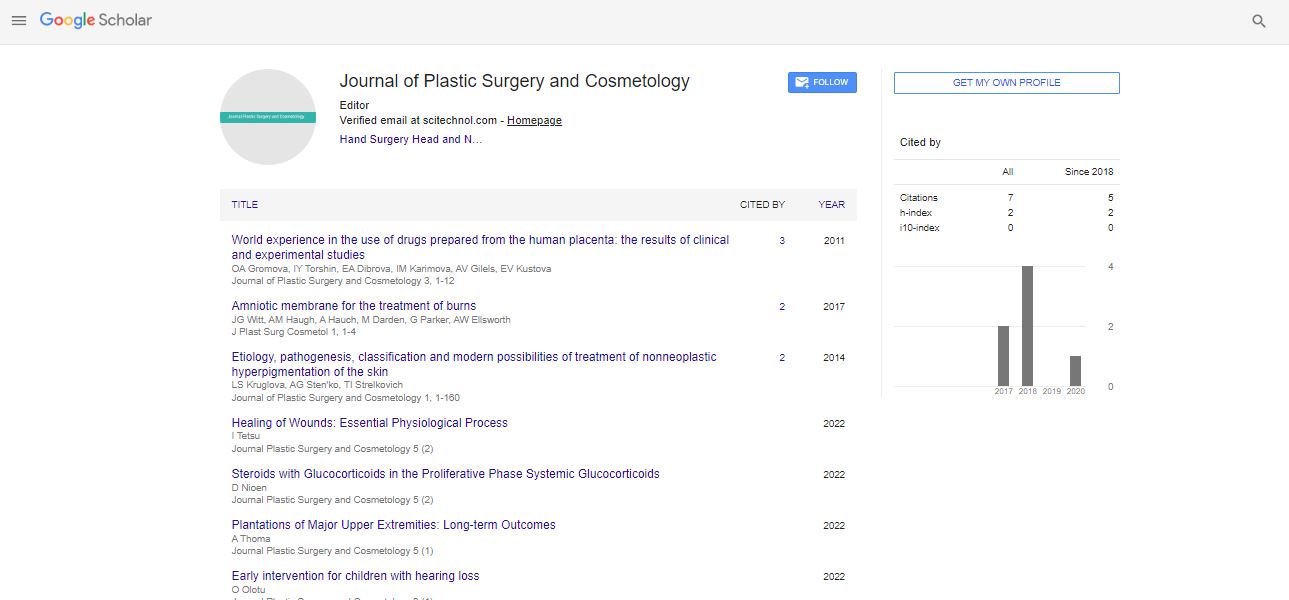Opinion Article, J Pls Sur Cos Vol: 12 Issue: 4
Innovative Approaches to Scar Prevention and Management in Plastic Surgery: A Comprehensive Review
Oliva Vera*
1Department of Biology, University of Minho, Braga, Portugal
*Corresponding Author: Oliva Vera,
Department of Biology, University of Minho,
Braga, Portugal
E-mail: Veraolova989@gmail.com
Received date: 27 November, 2023, Manuscript No. JPSC-24-123945;
Editor assigned date: 29 November, 2023, Pre QC No. JPSC-24-123945 (PQ);
Reviewed date: 14 December, 2023, QC No. JPSC-24-123945;
Revised date: 21 December, 2023, Manuscript No. JPSC-24-123945 (R);
Published date: 28 December, 2023, DOI: 10.4172/JPSC.1000065
Citation: Vera O (2023) Innovative Approaches to Scar Prevention and Management in Plastic Surgery: A Comprehensive Review. J Pls Sur Cos 12:4.
Description
The quest for optimal scar prevention and management in plastic surgery has fueled continuous innovation in techniques and technologies. Scarring represents a significant concern for both patients and practitioners, and advancements in this field aim to enhance outcomes, minimize visible scars, and improve overall patient satisfaction. This essay reviews novel approaches in scar prevention and management within the realm of plastic surgery, exploring emerging techniques and technologies that hold promise for revolutionizing the way scars are addressed. The use of topical agents and dressings has evolved to mitigate scarring. Silicones, for instance, have shown efficacy in preventing hypertrophic scars and keloids. Novel formulations, such as silicone gel sheets and sprays, offer improved convenience and patient compliance. Additionally, emerging dressings incorporating advanced materials like hydrogels and polyurethane foams promote a moist wound environment, optimizing conditions for reduced scarring.
Intralesional steroids remain a standard approach for managing hypertrophic scars and keloids. However, ongoing research explores novel steroid formulations and combinations with anti-inflammatory agents to enhance efficacy while minimizing side effects. The development of targeted drug delivery systems holds promise in optimizing the local delivery of therapeutic agents to scars. Advances in tissue glues and adhesives aim to replace traditional sutures and staples, minimizing tissue trauma and scarring. Cyanoacrylate-based adhesives offer an efficient and cosmetically favorable alternative for wound closure. Furthermore, the development of bioadhesives with tissue-specific properties holds potential for enhanced scar outcomes.
Laser technology has expanded its applications in scar prevention and management. Fractional laser treatments stimulate collagen remodeling and improve scar texture. Emerging laser technologies, such as non-ablative and ablative fractional lasers, provide practitioners with versatile tools for addressing different types of scars, including atrophic and hypertrophic scars. Microneedling, involving the use of fine needles to create controlled micro-injuries, has gained popularity in scar revision. The technique stimulates collagen production and enhances the penetration of topical agents. The integration of dermal rollers with microneedling further amplifies its effectiveness in improving scar appearance and texture.
Platelet-Rich Plasma (PRP) Therapy involves the extraction and concentration of platelets from the patient's own blood, which is then injected into scar tissue. Rich in growth factors, PRP promotes tissue regeneration and collagen synthesis. Ongoing research explores optimized PRP formulations and delivery methods to maximize its efficacy in scar management. The integration of 3D bioprinting represents a cutting-edge approach to scar prevention. Researchers are exploring the use of bioprinted skin substitutes that closely mimic the structure and function of natural skin. These substitutes, composed of living cells and supportive matrices, have the potential to reduce scarring by promoting faster wound healing and improved tissue regeneration.
Electroceuticals, or electronic devices designed to modulate the body's electrical signals, show promise in scar prevention. Devices such as microcurrent stimulators and electrospinning technologies aim to influence cellular behavior, collagen deposition, and angiogenesis, all of which contribute to the formation and appearance of scars. Despite the promising developments, the field of scar prevention and management faces challenges related to standardization and the need for robust scientific evidence. Establishing standardized protocols for the use of emerging technologies and conducting rigorous clinical trials are essential to validate their safety and efficacy.
Individual variations in healing processes, genetics, and lifestyle factors contribute to the complexity of scar outcomes. Personalized approaches, taking into account patient-specific factors, may be necessary for optimizing the effectiveness of scar prevention and management strategies. The landscape of scar prevention and management in plastic surgery is evolving rapidly, driven by innovative techniques and technologies. As research continues to uncover new avenues, the integration of personalized and targeted interventions holds the key to transforming the way scars are addressed in clinical practice. By navigating challenges and leveraging the full potential of emerging approaches, the field is poised to usher in a new era of scar management that prioritizes patient satisfaction and aesthetic outcomes. As plastic surgeons embrace these novel strategies, the pursuit of scarless or minimally visible scars becomes an achievable goal, contributing to enhanced patient well-being and confidence.
 Spanish
Spanish  Chinese
Chinese  Russian
Russian  German
German  French
French  Japanese
Japanese  Portuguese
Portuguese  Hindi
Hindi 